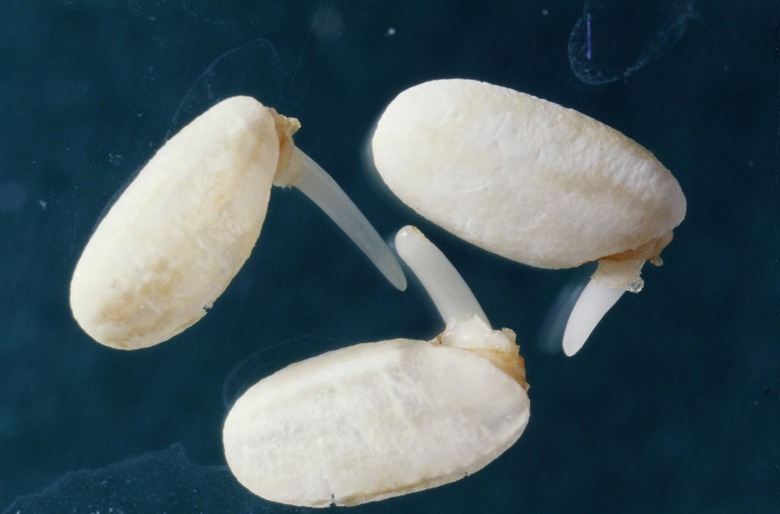Soybean Sprouts Compared To Mung Bean Sprouts
Sprout beans at home for a constant source of cheap and nutritious fresh vegetables. Home production using organic seeds purchased from a trusted source avoids the rare health concerns over mass-produced sprouts. Compare soy, mung, lentil and adzuki bean sprouts to learn their particular flavors. Wash your hands before handling sprouts, rinse thoroughly before eating and keep seeds in a cool and dry place.
Nutritional Values
Nutritional Values
Soy and mung bean sprouts are year-round sources of low-fat food that contain no cholesterol. They both contain B vitamins, including thiamin, riboflavin, niacin, pantothenic acid and folic acid. They're also good sources of dietary fiber and vegetarian protein. Soybeans contain 20 to 25 percent vegetable protein; mung beans contain 22 percent. Six oz. of mung beans contain 60 calories and the same amount of soybeans has 200 calories. Both kinds of sprouts are at their most nutritious as soon as tiny green leaves show at the tips.
Growing Soybean and Mung Bean Sprouts
Growing Soybean and Mung Bean Sprouts
Some beans are easier to sprout than others. Mung beans need eight to 12 hours of soaking, sprout in two to five days and keep for two to six weeks. Soybeans are more difficult to sprout, often splitting open, discoloring and developing a bitter taste if not used when very young. Soybeans require soaking for between two and four hours, sprout in two to six days, keep refrigerated for two to four weeks and yield double the amount of sprouts to beans.
Uses of Soybean and Mung Bean Sprouts
Uses of Soybean and Mung Bean Sprouts
Mung beans are the most common and easily available type of sprouts. They feature largely in Asian cuisines and have a sweet, nutty flavor and crisp texture. Uses include adding to cooked dishes at the end of the process. These thick-stemmed sprouts can withstand several minutes worth of cooking. Mung beans sprouts can be stir-fried or cooked in traditional Chinese dishes like chicken chow mein and chop suey, or eaten raw in salads and sandwiches. Soybeans have a more pronounced bean-like flavor and are often preferred cooked, even by enthusiastic sprout eaters. Soybeans are harder to digest when raw, so try cooking them in stews and soups, or adding to a stir-fry. Served raw or cooked, 12 oz. of either mung or soy bean sprouts are enough to serve in salads or as a side dish for between four and six guests. Rinse both types of sprouts well before cooking or eating raw.
Health Benefits
Health Benefits
The benefits of mung beans are those associated with all bean sprouts. They contain the dietary necessities of fresh vegetable protein and fiber, as well as C and B vitamins. Soybean sprouts also confer the same protective benefits as other soy products like tofu, tempeh, soy milk and soy sauce. These benefits include possible reductions of the risk of heart disease by lowering LDL cholesterol. In Asia, where consumption rates of soybean products are high, rates of prostrate and breast cancers are low. Active ingredients thought to be responsible for this protection action are the substances daidzein and genistein. Women with estrogen-positive breast cancer must avoid soybean sprouts, because they contain plant hormones that may stimulate the growth of their tumors.
